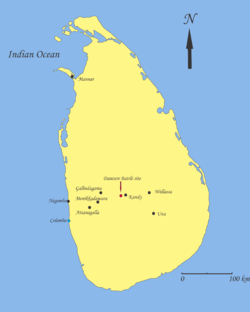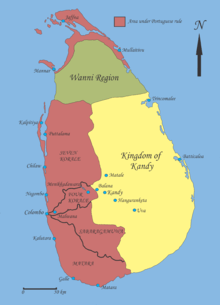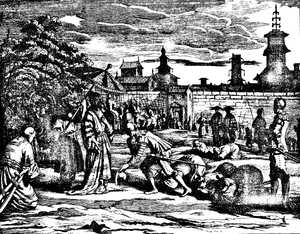Sinhalese–Portuguese War
| |||||||||||||||||||||||||||||||||
The Sinhalese–Portuguese War was a series of conflicts waged from 1527 to 1658 between the indigenous Sinhalese kingdoms of Ceylon (now Sri Lanka) and their allies against the Portuguese Empire.[1] The Portuguese were seeking to expand from their trading post at Colombo to incorporate Ceylon into their growing empire.
The Portuguese expanded their influence on the island by exploiting the political rivalries of the native kingdoms, placing client rulers on the thrones of several kingdoms and directly ruling other areas as Portuguese Ceylon. These machinations allowed them to control the Kingdom of Kotte, but the main beneficiary was the Kingdom of Sitawaka, which from 1521–87 was able to expand – through conquest of other native kingdoms – to cover most of Ceylon. Most of the newly conquered territories then rebelled against Sitawaka. The divided and disorganised rival kingdoms became easy targets for Portuguese expansion.
In a series of military conflicts and political manoeuvres the Portuguese extended their control over the kingdoms of Kotte (1551), Jaffna (1591), Raigama (1593) and Sitawaka (1593). In 1592 they placed a client ruler on the throne of the Kingdom of Kandy, but he died soon after in suspicious circumstances and the Portuguese were forced to withdraw. Seeking to subdue the last remaining resistance on Ceylon, the Portuguese launched a full military invasion of Kandy in the Campaign of Danture of 1594. The invasion was a disaster for the Portuguese, with their entire army wiped out by Kandyan guerilla warfare.
The war became a stalemate, with further Portuguese attempts to conquer Kandy repeatedly repulsed, whilst the Kandyans were unable to oust the Portuguese from the rest of the island. However the Portuguese were able to conquer the Vanni chieftains in 1621. This stalemate was eventually broken by the intervention of the Dutch East India Company in 1638, who sought to exploit the war to take over Portuguese colonial possessions. The Dutch initially entered the war as allies of Kandy, and together they won several battles against the Portuguese. However the alliance did not last and the three remaining powers fought each other in triangular warfare for a time. The Dutch and Kandyans re-made their alliance in 1649 to drive the Portuguese from the island. The Portuguese capital Colombo was conquered in 1656, but once this was done the Dutch immediately betrayed their allies, keeping the Portuguese possessions for themselves.
By the end of the war in 1658 all Portuguese forces had been expelled from the island, ending Portuguese Ceylon. The Kingdom of Kandy was the only surviving indigenous state on Ceylon, ruling almost half of the territory. The Dutch were left in control of the major population centres, forming Dutch Ceylon.
Origin
The Portuguese arrived in Sri Lanka in 1505[2] and established trade relations with the Kotte kingdom.[3] During the early 16th century their intentions were directed towards defending their trading interests, particularly the lucrative spice trade.[4] However, with time this policy gradually changed to territorial ambitions with the objective of outright conquest.[5] Island resources, Sri Lanka's strategic location for both trade and naval security and rise of the Mughal empire in India were influencing this change.[6][note 1]

In 1521, the three sons of the Kotte king Vijayabahu VII rebelled against their father. After killing Vijayabahu his sons (Bhuvanekabahu, Pararajasingha and Mayadunne) divided the kingdom among themselves in the 'Spoiling of Vijayabahu'. Mayadunne received the Kingdom of Sitawaka, Pararajasingha was given the Principality of Raigama (taking the name Raigama Bandara), and Bhuvanekabahu ruled over the remaining part of Kotte (as Bhuvanekabahu VII). The subsequent rivalries between these three new realms gave the Portuguese an opportunity to expand their influence on the island, by becoming involved in its internal politics.[7][8]
Early stages 1521–1538
During the initial encounters, the Portuguese lent their assistance to the Bhuvanekabahu VII of Kotte to defend against the attacks from Sitawaka.[9] Their influence over the Kotte grew with the military aid they provided.[4]
Sitawaka expansion 1538–1587

In 1551, this uneasy alliance came to an end with the death of Bhuvanekabahu VII as a result of a shot fired by a Portuguese soldier which he claimed to be an accidental discharge of the weapon.[10][11] Following his death his young grandson was established on the Kotte throne under the protection of the Portuguese. Later his conversion to Christianity and becoming a vassal of Portuguese emperor[12] sparked a series of campaigns between the Portuguese and the Sinhalese[13] who were led first by the kingdom Sitawaka and then by the kingdom of Kandy.
Portuguese takeover of Jaffna and Sitawaka 1588–1593
In 1588 Kandy rebelled against its new Sitawaka rulers. However, the heirs of the Kandyan royal family had fallen under Portuguese influence and were held in Colombo. In 1592 the Portuguese intervened in Kandy, placing their protégé Yamasinghe Bandara on the throne. However, the new ruler died in suspicious circumstances shortly after his coronation. The Portuguese accused a rival Kandyan faction of poisoning Bandara, but the Kandyans blamed the Portuguese, who were forced to withdraw. Vimaladharmasuriya I became the new king of Kandy.
Meanwhile, the Jaffna Kingdom in the north of the island fell increasingly under Portuguese influence. In 1591 a Portuguese expedition deposed (and killed) the Jaffna king Puviraja Pandaram, then installed his son Ethirimana Cinkam as a client ruler.
In 1593 Sitawaka forces attempted to re-take Kandy, but were repulsed and their king Rajasinha I died of disease contracted during the fighting. One of the rival claimants to his throne defected to the Portuguese, enabling them to take complete control over Sitawaka.
Campaign of Danture 1594

The Portuguese tried again to put their preferred candidate on the throne of Kandy as a client ruler. This time it was Dona Catarina, a Kandyan princess who had been entrusted to the care of the Portuguese and brought up in a Catholic European style. She was then aged ten or twelve.
Pedro Lopes de Sousa led a force of about 20,000 in an invasion of Kandy, of which one thousand were Portuguese troops (the majority transferred from Goa in India for the expedition), 15,400 native Lascarin allies, 47 elephants used as pack animals,[note 2] and the remainder Badaga mercenaries from India and coolie labourers. The initial number of opposing Kandyan forces is unknown, but is estimated at 10,000. The defenders held a distinct advantage in the terrain, as Kandy is a mountainous region and the invading force would be forced to traverse well-defended mountain passes.
The Portuguese stormed the pass at Balana with heavy losses, after which the Kandyan forces began to retreat before the invaders. The Portuguese were able to enter the capital Kandy without resistance, finding it abandoned by King Vimaladharmasuriya I. Dona Catarina was crowned as the new ruler of the Kingdom of Kandy. However she and her Portuguese advisers were unpopular rulers, particularly after rumours spread that she was to be married to a Portuguese husband (as the Portuguese were indeed planning).
Vimaladharmasuriya's forces engaged in guerilla tactics, attacking Portuguese foraging parties and cutting off lines of supply and communication. A large Portuguese-Lascarin raiding party of 3,000 men was surrounded and destroyed in the Uva region. Shortly thereafter, evidence was found that Jayavira Bandara Mudali, one of the Lascarin chieftains, was preparing to betray the Portuguese to Vimaladharmasuriya. Part of this evidence was later shown to be fabricated by Vimaladharmasuriya, but Jayavira was killed as a traitor before this was realised.
The death of Jayavira led many of the Lascarins to desert, along with all of the Badaga mercenaries. Less than a thousand native allies were left with the Portuguese forces, who were now massively outnumbered, lacking supplies, and faced a mass rebellion. The Portuguese attempted to retreat from Kandy to the fort at Balana. Losses to guerilla warfare and further Lascarin desertions reduced their forces to about 360 Portuguese and an equal number of Lascarins by the time they reached Danture. In contrast, defections and troops arriving from other parts of the kingdom had swelled Vimaladharmasuriya's forces to about 20,000 men.
At Danture, the Portuguese forces were attacked as they retreated. The organised columns disintegrated in the forest and most were wiped out. Sousa surrendered with the remaining 93 European troops. In a departure from usual Sinhalese warfare, the prisoners were tortured and mutilated. Sousa died of the wounds he sustained during the fighting. With the exception of a patrol sent back to the lowlands during the early part of the campaign, only three Portuguese soldiers escaped back to Colombo.
Vimaladharmasuriya solidified his control over Kandy by marrying Dona Catarina. In an attempt to prevent further Portuguese incursions he built new fortifications in the Balana pass. The Campaign of Danture was the turning point of the long-running war and the apex of Portuguese power on Ceylon.
Stalemate 1595–1637

Dutch intervention 1638–1658

The kingdoms of Spain and Portugal had been in dynastic union under the Spanish Habsburgs since a Portuguese succession crisis in 1580. This Iberian Union possessed a vast empire of colonial possessions, but lacked the strength (particularly naval forces) to defend them. Other colonial powers sought to take advantage of this weakness to obtain their own empires, particularly after the collapse of the Iberian economy in 1627. The Spanish overseas possessions were generally better defended than Portuguese ones, which were widely scattered and difficult to reinforce.
The rival Dutch Empire – engaged in the Eighty Years' War against its former master, Spain – concentrated its overseas efforts on conquering parts of the Portuguese Empire in the Dutch–Portuguese War. The Dutch East India Company (VOC) sought to oust the Portuguese from the East Indies and Indian subcontinent so they could control the lucrative spice trade. Seeing an opportunity to undermine the Portuguese on Ceylon, the VOC made contact with the Kingdom of Kandy. Confidence in the Kandyan forces rose after they defeated a Portuguese army at the Battle of Gannoruwa in March 1638. Shortly thereafter, the VOC and Rajasinha II of Kandy signed a treaty in May 1638, by which the VOC promised to aid Kandy in its continuing war against the Portuguese in exchange for a monopoly on many trading goods.
The combined VOC and Kandyan forces gradually wore down the Portuguese forces, pushing them out of their strongholds across the island. Batticaloa on the East coast fell to Dutch forces in 1639, then Negombo on the West coast in 1640. Galle was captured after a siege in 1640, providing the Dutch with a port and naval base. However the Kandyans became suspicious of their new allies, correctly believing that the VOC goal was not just to remove the Portuguese from Ceylon, but to replace them as the colonial power. The alliance fell apart after a ceasefire was agreed between Dutch and Portuguese forces at some point between 1641 and 1645.
Kandyan forces engaged in skirmishing with both Dutch and Portuguese forces over the following years, but were unable to make inroads. The VOC and Kandy returned to negotiations and reformed their alliance in 1649, albeit on different terms. Meanwhile, the Iberian Union had ended in 1640, depriving the Portuguese colonies of Spanish support. The Peace of Münster in 1648 had ended the Dutch war with Spain (but not Portugal). These developments together acted to free up Dutch forces from other conflicts, allowing them to concentrate on their attacks on Portuguese colonies.
The VOC-Kandy alliance went on the offensive in Ceylon from 1652. Whilst Kandy controlled the interior of the island, it was landlocked and the Dutch fleet were able to dominate the coast. Two naval actions were fought between the Dutch and Portuguese on 23 March near Colombo and 2 May 1654 near Goa; the Portuguese won the first battle but lost their entire Indian subcontinent fleet in the second. The Dutch placed the main Portuguese base of Colombo under siege in 1655. Rajasingha no longer trusted the Dutch and insisted that Colombo be ceded to Kandy as soon as it fell. However, when the city finally fell in 1656, the Dutch immediately closed the gates against their ally.
Faced with a complete breakdown in relations with the Dutch, the Kandyan's broke off the alliance and pillaged the area around Colombo. They then retreated back inland and resumed their war with the Dutch, which would continue intermittently for the next century.
The last Portuguese forces were expelled from Ceylon entirely in 1658. The VOC was left in control of Colombo and much of the surrounding coastline, forming Dutch Ceylon.
Aftermath
By the end of the war, the Portuguese had lost all of their possessions on Ceylon along with their trading rights. Portuguese Ceylon ceased to exist.
The Dutch were left in control of numerous ports and fortifications along the coastline, along with the major population centres of Colombo and Galle. Their possessions on the island were organised into the colony of Dutch Ceylon. Over the following century the colony gradually expanded its holdings on Ceylon, and engaged in sporadic warfare with Kandy. Eventually the Kew Letters of 1795 led to the transfer of the Dutch possessions on the island to the British in 1796, forming British Ceylon.
The Kingdom of Kandy retreated to the highlands in the interior and east of the island. They continued to resist European influence on Ceylon, engaging in skirmishing and guerilla warfare without making significant inroads into the lowlands. Kandy maintained its independence until 1815 when it was conquered by the British.
References and notes
Notes
- ↑ The rise of the Mughal empire led to an increase in efforts on Sri Lanka by the Portuguese, as evident by a claim made by Lisbon. "If someday India should be lost it could be recovered from Ceylon."[5]
- ↑ The elephants were used for logistics and not as combat war elephants
References
- ↑ Ring, Trudy (1996). International Dictionary of Historic Places: Asia and Oceania. Taylor & Francis. p. 443.
- ↑ S.G. Perera p 8.
- ↑ S.G. Perera p 11.
- 1 2 Gaston Perera p 144.
- 1 2 Gaston Perera p 145.
- ↑ Gaston Perera p 145 – 146.
- ↑ Rajavaliya p 77.
- ↑ S.G. Perera p 20.
- ↑ S.G. Perera p 18 – 23.
- ↑ Paul E. Peiris p 115 – 116.
- ↑ Rajavaliya p 79.
- ↑ S.G. Perera p 37 – 44.
- ↑ Queyroz p 326 – 341.
Bibliography
- B. Gunasekara, The Rajavaliya. AES reprint. New Delhi: Asian Educational Services, 1995. ISBN 81-206-1029-6
- C. Gaston Perera, Kandy Fights the Portuguese – A Military History of Kandyan Resistance. Vijithayapa Publications: Sri Lanka, June 2007. ISBN 978-955-1266-77-6
- Paul E. Peiris, Ceylon the Portuguese Era: Being a History of the Island for the Period, 1505–1658, Volume 2. Tisara Publishers: Sri Lanka, 1992. (Link). OCLC 12552979.
- da Silva, O. M. (1990). Fidalgos in the kingdom of Kotte, Sri Lanka, 1505–1656: the Portuguese in Sri Lanka. Colombo, Sri Lanka: Harwoods Publishers.
- S.G. Perera, A History of Ceylon For Schools – The Portuguese and Dutch period. The Associated Newspapers of Ceylon: Sri Lanka, 1942. (Link). OCLC 10531673.
- Winius, George D. (1971). The fatal history of Portuguese Ceylon; transition to Dutch rule. Cambridge, Massachusetts: Harvard University Press. ISBN 978-0-674-29510-0.
